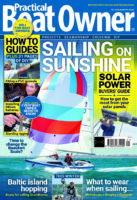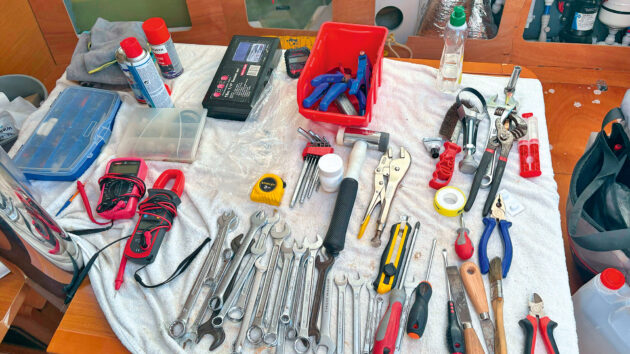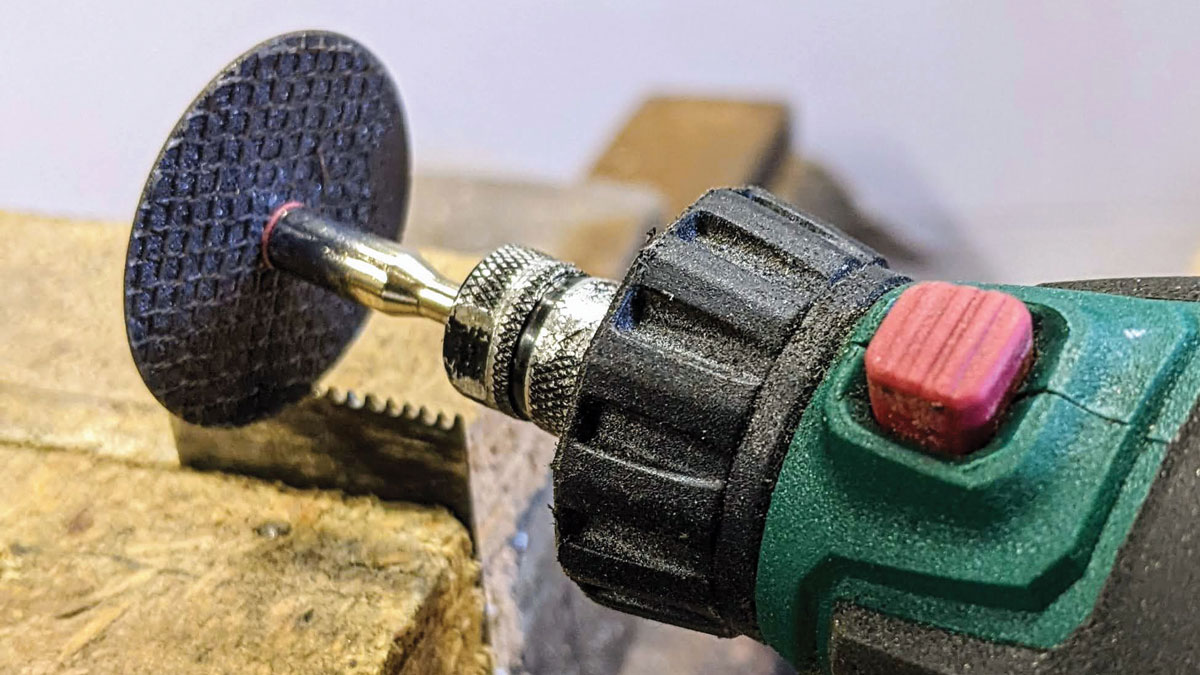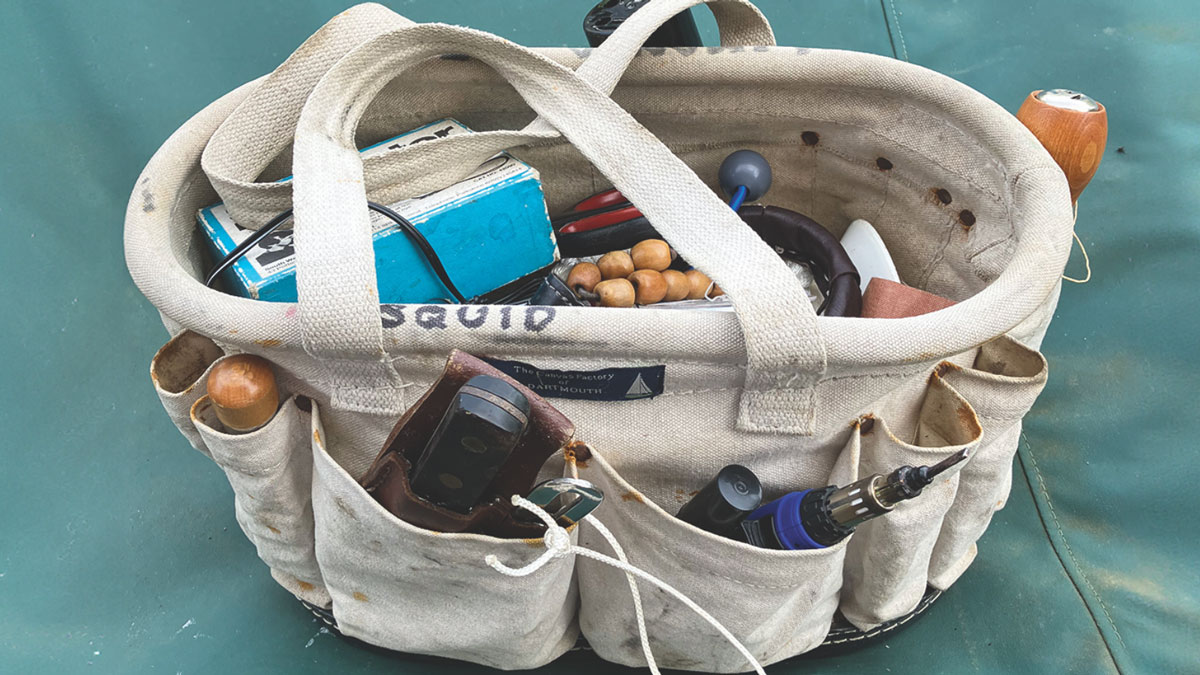Stu Davies explains the essential tools for a boat, and what he keeps handy to make sure he can tackle (almost) any job on board.
What tools do you really need for a boat?
Say you now own a new or new-to-you boat, and you’re ready to get going. What happens if something breaks while you’re sailing or boating? Who will fix it? Can you fix it, and of course, what tools do you need for the job?
The cost and quality of the tools for a boat also come into play, too.
The first decision you have to make is, who is going to repair my boat? Can you do it all yourself? Can you do a bit? Are you able to repair wood? Engines? Glass-fibre? Sails? Once you’ve answered those questions you can work out what you actually need and the quality of the tool you need to buy.
The age of your boat is also a factor. A very old vessel might need imperial spanners for the engine; later boats use metric sizes.
On our boat, my wife, Laura, and I generally do it all. I’ve got a tool bag on board with a selection of tools for a boat’s range of possible big maintenance jobs, plus I have a small day bag with screwdrivers, pliers, an adjustable spanner and side cutters which I use when doing little jobs.
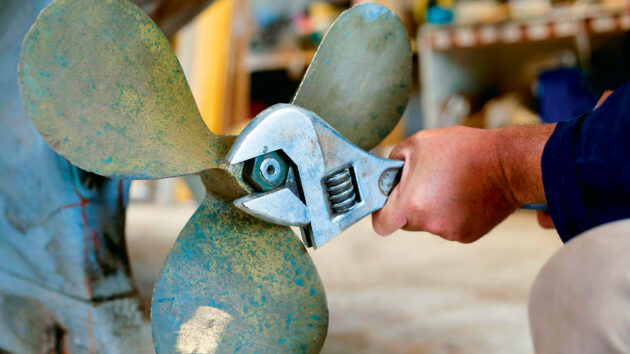
Adjustable spanners are useful for jobs like tightening the boat’s propeller. Photo: Connect Images / Alamy Stock Photo.
Laura has a Singer 201K sewing machine on board, which she has used to make a new cockpit tent with side windows as well as other repairs.
I’ve also got a mains-powered drill and a battery drill, plus a decent hacksaw, wood chisels, pullers for removing props etc and a heavy-duty pop riveter. I’ve also got an oscilloscope to go with my standard multimeter.
For basic maintenance, I have a pair of pliers, needle-nose pliers, a small electrical screwdriver, electrical side cutters, a medium size Pozidriv screwdriver, a medium flat blade screwdriver and a small adjustable spanner.
Any more tools than that need some careful thought.
Which tools do you need on a boat?
My next-door Portuguese neighbour in Albufeira Marina bought a hardware store kit from the megastore, Leroy Merlin. It was a big box, very flashy and seemingly just what you need… but is it?
The reality was the tool kit was not very good as it contained tools you never use, and the tools you do need for boat work were not there. To know what you need on board, you need to understand what different types of tools can do before deciding if you need to buy them.
Crosshead screwdrivers
Not all crosshead screwdrivers are the same. A Phillips screwdriver is the basic crosshead screwdriver, coming in four sizes. It was created and patented by Henry Phillips in the 1930s and was originally used on the 1936 Cadillac.
The great thing about it is that unlike the flathead screwdriver (with a single ridge at its tip to slide into a screw with one slot), the Phillips screwdriver is self-centring.
A Pozidriv crosshead screwdriver looks similar but has different angles and doesn’t fit properly into a Phillips screwhead.
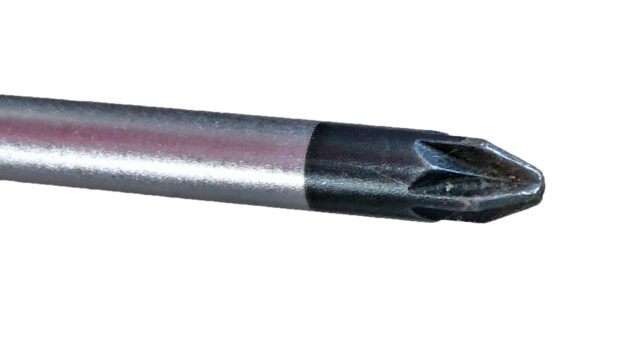
Pozidriv screwdriver is identifiable by the little indent marks between the crosshead. Photo: Stu Davies.
Then, of course, we have JIS (Japanese Industrial Standard) headscrews. This is a crosshead screw but with different angles in the screwhead.
If you use the wrong screwdriver in the wrong head, the crossheads will be damaged, and the screwdriver will slip out. The screw then becomes impossible to undo. Those of us old enough to remember the first Honda motorcycles arriving in the UK will know to our cost what damage using the wrong screwdriver head can do. The motorcycles had JIS screws and many of us unknowingly used Philips screwdrivers which mangled the screws!
Most screws on our boats are Pozidriv, identified by little marks in between the cross on the screws and on the screwdriver.
Make sure you use the right screwdriver for these!
Flatblade screwdrivers
Large, medium and small flatblade screwdrivers are useful, plus an electric mains neon test screwdriver for electrical circuit testing. The large flatblade screwdriver can be used for light prying too (we all do it!).
Don’t use flatblade screwdrivers as cold chisels. I also have a set of instruments screwdrivers for carrying
out delicate work.
What spanners do I need?
To choose the correct tools for a boat, you need to look at the age of your boat and which engine is fitted. Older engines might need imperial-sized spanners or unified thread spanners; modern engines use metric spanners.
Do I need an adjustable wrench? They absolutely have their place in your tool kit, but must be used properly; the jaws must fit tightly on the fastener.
There are myriad versions of basic spanners and wrenches nowadays. Years ago, we used black steel open-ended spanners.
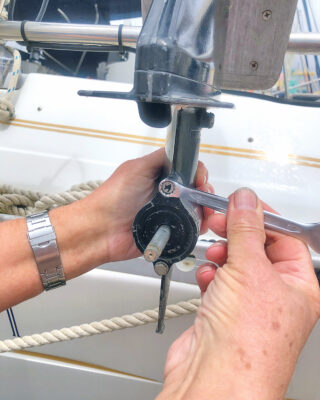
Ring spanners are useful, especially in tight spaces. Photo: Stu Davies.
Nowadays, combination wrenches with a ring spanner on one end and an open end on the other are most common. Made of chrome vanadium steel, these spanners are nicely chromed, easy on the hands and easy to use.
People often ask why the jaws are angled, offset from the main handle. The most common angle is 15°, deliberately engineered to allow small movements of the spanner as it is turned over, so it is perfect for use in confined spaces. The ring spanner lands are similarly angled for the same reason.
There are also ratchet ring spanners for use in confined spaces, as users can tighten or loosen fastenings without having to reposition the spanner.
France has a strange system where their hand wrenches are like sockets on an L-shaped bar.
As for American tools, there are tools for everything; it seems they invent something for every job!
A good set of adjustable vice grips, known as Mole grips, is important as they can be used as a portable vice as well. I’ve used them to clamp material to a pontoon cleat to hold while cutting or filing.
I also have a set of Stilsons pipe wrenches on board, used for holding the prop shaft flange coupling when working on the prop shaft, plus other ‘big’ things.
Files
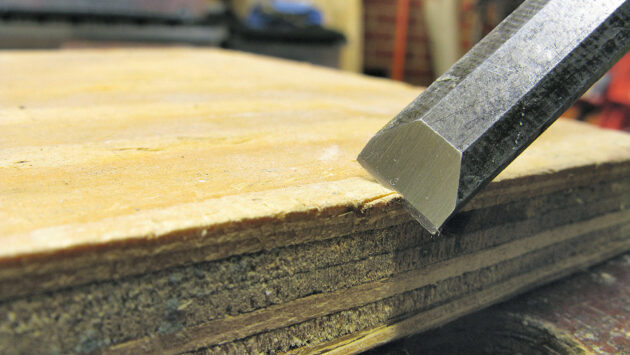
Make sure you keep your wood chisel sharp.
I have a half-round rough file used for filing flat stuff and big holes, and a rat tail file (named because it looks like a rat tail) for enlarging small holes.
Riveting tools for a boat
I have a normal pop rivet gun plus a heavier-duty concertina type for setting ¼in monel rivets in the mast fittings.
Socket sets
I will argue that a full set is not really necessary. Buy the sockets you need separately. Plus a breaker bar, a ratchet head driver and a couple of various-sized extension bars. I started with the remnants of an old ½in metric drive set with 10mm, 12mm, 13mm, 14mm and 17mm sockets. I bought specific sockets as I needed them.
Pliers
Thin nose and regular pliers are essential, plus side cutters.
Circlip pliers are a must if you intend to do any serious work on winches, roller reefing gear and autopilots.
Oil change tools for a boat
A Pela oil extractor pump is a must for oil changing duties and sucking liquids out of inaccessible places. You also need an oil filter wrench, which is a flexible tool that fits around the oil filter to allow it to be unscrewed.
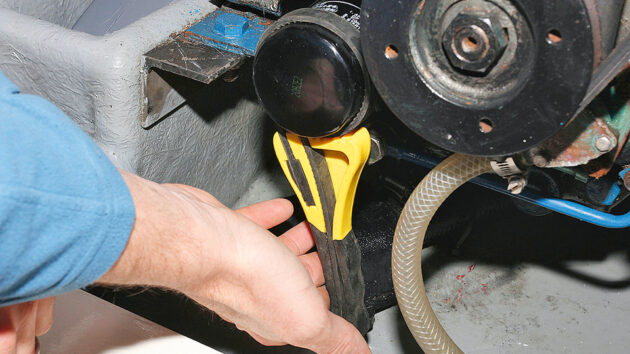
An oil filter wrench is necessary for changing the engine oil filter.
I have one, bought in a French supermarket on the way to Portugal, with a flexible, adjustable spring steel band that fits around the filter to give some purchase to unscrew it. It was cheap, but it works well.
Taps and dies
I have a budget set of metric thread taps and dies on board; they are handy for cleaning up threads.
Keys
A metric set of Allen keys is important to have; a budget set will meet your needs.
Anyone with a newer boat might also require a set of Torx Keys for adjusting Torx fasteners.
Hacksaws
A good one is essential. Make sure you buy the best blades you can afford, such as the Eclipse brand, which is usually blue and is made of high-speed steel. Twenty-four teeth per inch is the best size.
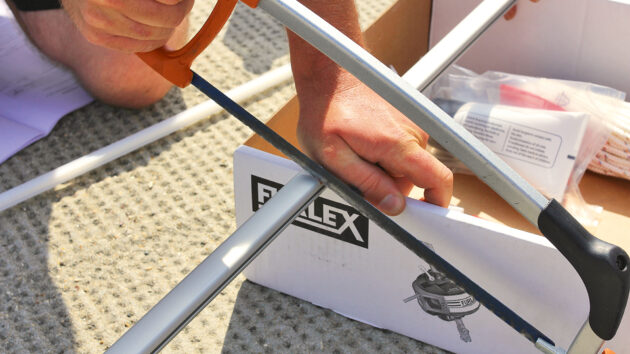
It is best to buy the best blades you can afford for your hacksaw.
My mast rigging cutter is my hacksaw; it can cut through an 8mm wire in a couple of strokes, and is much more reliable than a rechargeable battery angle cutter, as there is no battery to go flat.
When using a hacksaw, make sure you use the whole length of the blade to cut; otherwise, the middle section gets worn more than the rest, leading to it breaking. A junior hacksaw is useful to have, too.
Wire cutters
Many people have wire cutters on board in case they need to cut through rigging after a dismasting.
I look at them with a jaundiced eye. Inevitably, they are cheap, the blades usually chip if they are not used properly, and when using them, you need one handle wedged on the deck with your whole body weight pushing on the other handle. I will take my chances with a hacksaw and a pair of pliers to pull the cotter pins of the rigging.
Drills
I have high-speed steel drill bits for some materials, such as carbon steel; a set I bought at Lidl for everyday jobs and a selection of Dormer drill bits that are made especially for stainless steel. They have a special angle and back angle on the cutting edge. Push hard on the drill and use a slow speed with copious amounts of lubrication and they cut through stainless steel easily.
As for an electric drill, I have an ancient Makita battery drill that is 30 years old, still going strong, plus a cheap supermarket mains electric drill for tougher, longer jobs. They are both variable speed.
Chisels
A sharp wood chisel is handy for woodworking, trimming bits of wood or adjusting door hinges.
A small cold chisel is also good; kept sharp, it can be used with a ball pein hammer to cut steel.
Hammers
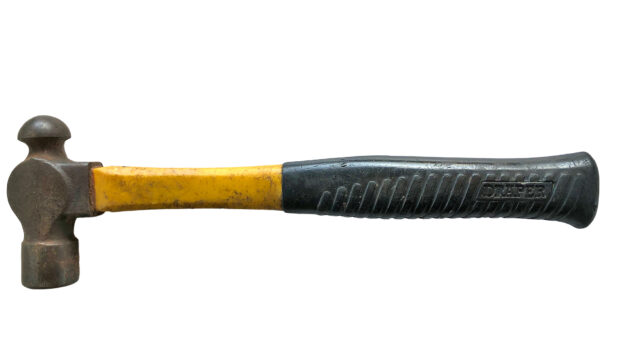
The ball pein hammer is versatile and has many uses. Photo: Stu Davies.
An engineer’s ball pein hammer is an invaluable tool, especially in skilled hands. I have used one for cutting metal with a cold chisel to refitting bearings and riveting.
Pin punches
Some people will question this, but a pin punch is invaluable for knocking out tight-fitting door hinge pins and water pump drive pins.
Also, most people don’t realise, but there is most likely a chain and sprocket in their boat’s steering system. If you need to repair that chain, a pin punch can come in handy to punch chain pins out.
Pullers
I have a cheap, large three-legged puller and a two-legged puller. The three-legged puller is used for removing the prop, which it does admirably, and the two-legged, smaller one for changing bearings in water pumps and pulling the prop shaft gearbox flange.
Flashlights
Yes, it’s a tool – and an indispensable part of the boat. I started with what we used to call a ‘Steamer Scarer’ which was very popular 25 years ago before the advent of powerful LED torches. It was a small lead acid battery in a large handheld housing and a car headlight-type halogen bulb.
They were amazing when they first came out, easily throwing a powerful beam a quarter of a mile, but their shortcomings soon became known; the battery didn’t last long!
We used ours in anger once off Cadiz in the middle of the night as we were making passage from Gibraltar to Faro. A merchant vessel was stooging offshore Cadiz, and was coming straight at us. His AIS was switched off. I shone the ‘Steamer Scarer’ on his bridge, and the boat came alive. The AIS was turned on and, having identified the vessel, I was able to call up the bridge to let the crew know how close they were and how much they had frightened us.
LED flashlights were a game changer, with their miserly power consumption and superb performance. My little LED flashlight, which is smaller than the inside of a toilet roll, is comparable in performance to the old Steamer Scarer. Our rechargeable LED headbands are superb for working in dark spaces below.
Rigging tools for a boat
Adjustable wrenches or Mole grips are useful for adjusting the turnbuckles on your rig. A rig tension gauge is also useful, or Google is your friend to find out how to use a tape measure or 1m rule to tension your rig. Some Tef-gel anticorrosion paste should be in your kit. I used to use Duralac, but found the oil in it oxidised and solidified.
Sewing sails and canvas-work
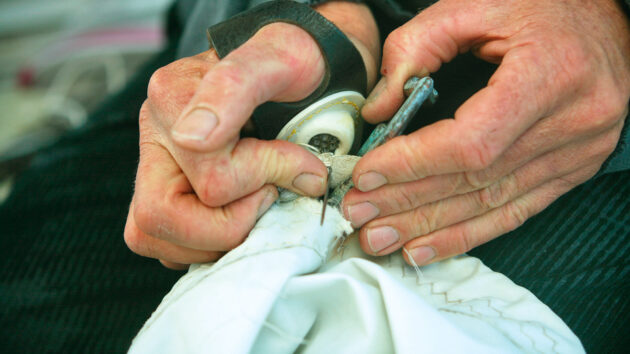
A sailmaker’s palm is an invaluable tool for sail repair. Photo: David Hancock / Alamy
As I have mentioned, Laura has a Singer sewing machine on board for both canvas and sail repair work.
For very thick sail work, we have a Speedy Stitcher. This is an American tool that slowly but surely will hand-punch through the thickest of material.
We also have a leather palm and sail needles, and together with V92 thread, we can repair most things.
Soldering Irons
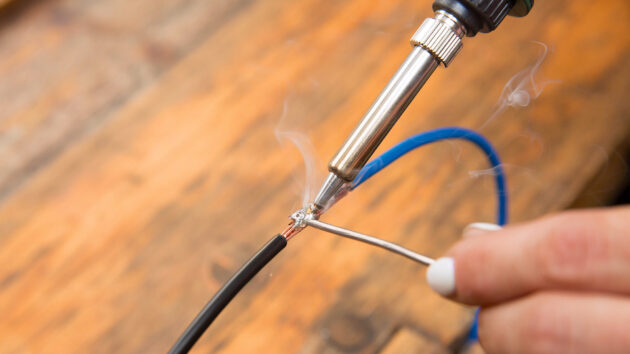
Being able to solder on board can quickly repair faulty electrics and electronics. Photo: Paul Quagliana.
I have two – one gas-driven and one powered by mains electricity. The mains one I run off my inverter.
They can be used for all sorts of jobs.
Recently I used the gas-driven soldering iron to punch holes through some new canvas cockpit sides to fit some Lift-the-Dot fasteners.
Wire crimpers
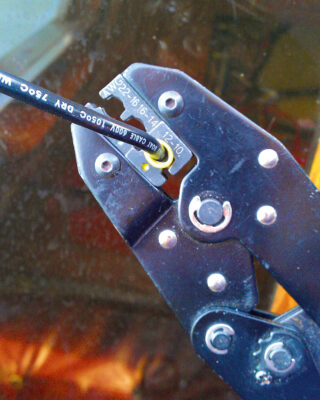
Wire crimpers are used for creating secure connections between wires and terminals. Photo: Duncan Kent.
Wire crimpers are essential to make safe, secure, electrical wire connections.
Each pair can accommodate three sizes of wire, marked by red, blue and yellow markers on the crimper jaws.
Red is for the smallest diameter wire, while yellow is the largest.
The tool usually has wire strippers and small bolt cutters built in.
Dremel
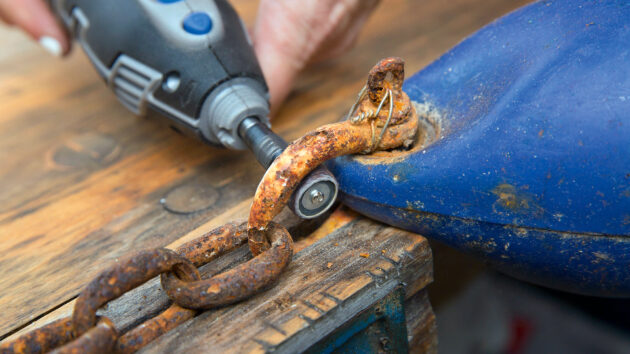
A Dremel rotary tool is perfect for light grinding work. Photo: Paul Quagliana.
This is a nice-to-have tool for a boat. It runs off my inverter, and is good for delicate grinding work and cutting glassfibre.
Antenna tuner tester
I have an SWR (Standing Wave Radio) meter, which I use to check the VHF antenna and cable. I spent many months trying to find out why my VHF radio wasn’t performing very well; this tool nailed it. The ground plane on the masthead antenna was corroded out.
Sharp pocket knives
Knives should be sharp because your life may depend on being able to cut a line cleanly and quickly. I carry a Swiss Army knife, while Laura always has a rigger’s knife. In Portugal, where we keep our boat, a sharp knife has to be carried on board
by law.
My Swiss Army Knife has Pozidriv and straight blade screwdrivers as well as the usual blades, which do work well.
Polishers
We have two on board, more by accident than design. We bought one of those budget two-handed oscillating polishers; Laura likes it, I don’t. The other polisher is an angle grinder type one with a very low speed. It is ideal for cutting gel coat to make it really shine.
Generators
We have a Honda 2kW generator on board, which was given to us a few years ago by a friend who was retiring from sailing. It is magnificent, as it starts easily after months of non-use.
We only have a 500W inverter, and this generator was the final piece in the puzzle to make off-grid anchoring civilised! Plus, it allows the use of powerful electric tools off-grid if they exceed the capabilities of my inverter.
Lubricants
While writing about tools for a boat, I would argue that WD-40, silicone grease and other lubricants come under that heading given their use in loosening parts, temporarily lubricating things and generally making parts easier to take apart. They are a must for me on board.
Which is the best make of tool for a boat?
The next question is: which make or quality of tool do you buy?
When I was an apprentice, the quality and material of tools were limited, with ex-World War II tools being common, including the Tommy wrench, a right-angled adjustable spanner.
Britool and King Dick brands became more prominent, with many tools made from chrome vanadium steel, which was sold as unbreakable and unbendable.
This was followed by Snap-on tools arriving from America. These tools were tactile and ergonomic but very expensive, unbreakable, and came with a so-called lifetime guarantee.
I have a Snap-on 3/8in drive metric socket set and other small tools at home, which I keep as ‘best’, but quite honestly, the choice nowadays at the budget end of the market is vast.
Tools made in the Far East have greatly improved in recent years and are very cheap. I find Silverline tools to be excellent, as well as the American brand Milwaukee and the range at Halfords in the UK.
Today, most tools sold by reputable retailers are usually good. Would I buy Snap-on tools for a boat? No.
Would I buy budget tools from a reputable dealer? Yes, I would and I do.
Don’t forget, expensive tools rust just as easily on your boat as budget ones!
Stu Davies has worked for most of his life as an oil field maintenance engineer in Africa and the Middle East. He has fixed a wide range of mechanical parts from the smallest of engines to 4,000hp gas turbines. He and his wife, Laura, own a Beneteau 381 which is based in Portugal.
How to make multitool blades last longer
Dick Everitt takes a DIY approach to make multitool blades last a little bit longer
Why you should consider the weight of boat tools
Minimise the need for weighty tools on board by swapping metal parts with wood and rope, and muffling those you…
Want to read more articles on the best tools for a boat?

A subscription to Practical Boat Owner magazine costs around 40% less than the cover price.
Print and digital editions are available through Magazines Direct – where you can also find the latest deals.
PBO is packed with information to help you get the most from boat ownership – whether sail or power.
-
-
-
- Take your DIY skills to the next level with trusted advice on boat maintenance and repairs
- Impartial, in-depth gear reviews
- Practical cruising tips for making the most of your time afloat
-
-
Follow us on Facebook, Instagram, TikTok and Twitter

